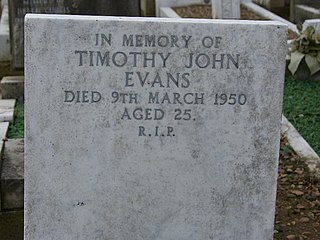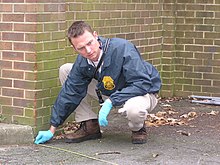
Forensic science, also known as criminalistics, is the application of science principles and methods to support legal decision-making in matters of criminal and civil law.
In United States criminal law, probable cause is the legal standard by which police authorities have reason to obtain a warrant for the arrest of a suspected criminal and for a court's issuing of a search warrant. One definition of the standard derives from the U.S. Supreme Court decision in the case of Beck v. Ohio (1964), that probable cause exists when “whether at [the moment of arrest] the facts and circumstances within [the] knowledge [of the police], and of which they had reasonably trustworthy information, [are] sufficient to warrant a prudent [person] in believing that [a suspect] had committed or was committing an offense.”
Criminal psychology, also referred to as criminological psychology, is the study of the views, thoughts, intentions, actions and reactions of criminals and suspects. It is a subfield of criminology and applied psychology.

A miscarriage of justice occurs when an unfair outcome occurs in a criminal or civil proceeding, such as the conviction and punishment of a person for a crime they did not commit. Miscarriages are also known as wrongful convictions. Innocent people have sometimes ended up in prison for years before their conviction has eventually been overturned. They may be exonerated if new evidence comes to light or it is determined that the police or prosecutor committed some kind of misconduct at the original trial. In some jurisdictions this leads to the payment of compensation.

The Police and Criminal Evidence Act 1984 (PACE) is an Act of Parliament which instituted a legislative framework for the powers of police officers in England and Wales to combat crime, and provided codes of practice for the exercise of those powers. Part VI of PACE required the Home Secretary to issue Codes of Practice governing police powers. The aim of PACE is to establish a balance between the powers of the police in England and Wales and the rights and freedoms of the public. Equivalent provision is made for Northern Ireland by the Police and Criminal Evidence Order 1989 (SI 1989/1341). The equivalent in Scots Law is the Criminal Procedure (Scotland) Act 1995.

Offender profiling, also known as criminal profiling, is an investigative strategy used by law enforcement agencies to identify likely suspects and has been used by investigators to link cases that may have been committed by the same perpetrator. The ancestor of modern profiling, R. Ressler of the FBI, considered profiling as a process of identifying all the psychological characteristics of an individual, forming a general description of the personality, based on the analysis of the crimes committed by him or her.

Environmental criminology focuses on criminal patterns within particular built environments and analyzes the impacts of these external variables on people's cognitive behavior. It forms a part of criminology's Positivist School in that it applies the scientific method to examine the society that causes crime.

Essex Police is a territorial police force responsible for policing the county of Essex, in the East of England. Essex Police is responsible for a population of over 1.8 million people and an area of 1,420 square miles (3,700 km2).
The FBI method of profiling is a system created by the Federal Bureau of Investigation (FBI) used to detect and classify the major personality and behavioral characteristics of an individual based upon analysis of the crime or crimes the person committed.

A crime scene getaway is the act of departing from the location where one has committed a crime. It is an act that the offender(s) may or may not have planned in detail, resulting in a variety of outcomes. A crime scene is the "location of a crime; especially one at which forensic evidence is collected in a controlled manner." The "getaway" is any escape by a perpetrator from that scene, which may have been witnessed by eyewitnesses or law enforcement.
A DNA database or DNA databank is a database of DNA profiles which can be used in the analysis of genetic diseases, genetic fingerprinting for criminology, or genetic genealogy. DNA databases may be public or private, the largest ones being national DNA databases.

Pre-trial detention, also known as jail, preventive detention, provisional detention, or remand, is the process of detaining a person until their trial after they have been arrested and charged with an offence. A person who is on remand is held in a prison or detention centre or held under house arrest. Varying terminology is used, but "remand" is generally used in common law jurisdictions and "preventive detention" elsewhere. However, in the United States, "remand" is rare except in official documents and "jail" is instead the main terminology. Detention before charge is commonly referred to as custody and continued detention after conviction is referred to as imprisonment.
The following outline is provided as an overview of and introduction to law enforcement:
The Criminal Investigation Branch (CIB) is one of the main branches of the New Zealand Police and it is dedicated to investigating and solving serious crime, and targeting organized crime and recidivist criminals. The CIB has existed since the civil Police Force was formed in 1886 by the Police Force Act 1886.
A serial rapist is someone who commits multiple rapes, whether with multiple victims or a single victim repeatedly over a period of time. Some serial rapists target children. The terms sexual predator, repeat rape and multiple offending can also be used to describe the activities of those who commit a number of consecutive rapes, but remain unprosecuted when self-reported in research. Others will commit their assaults in prisons. In some instances, a group of serial rapists will work together. These rapists can have a pattern of behavior that is sometimes used to predict their activities and aid in their arrest and conviction. Serial rapists also differ from one time offenders because "serial rapists more often involved kidnapping, verbally and physically threatening the victims, and using or threatening the use of weapons."

Forensic profiling is the study of trace evidence in order to develop information which can be used by police authorities. This information can be used to identify suspects and convict them in a court of law.

The Combined DNA Index System (CODIS) is the United States national DNA database created and maintained by the Federal Bureau of Investigation. CODIS consists of three levels of information; Local DNA Index Systems (LDIS) where DNA profiles originate, State DNA Index Systems (SDIS) which allows for laboratories within states to share information, and the National DNA Index System (NDIS) which allows states to compare DNA information with one another.
The importance of corroboration is unique to Scots criminal law. A long-standing feature of Scots law, the requirement for corroborating evidence means at least two independent sources of evidence are required in support of each crucial fact before an accused can be convicted of a crime. This means, for example, that an admission of guilt by the accused is insufficient evidence to convict in Scotland, because that evidence needs to be corroborated by another source.
In Indian English, a history-sheeter is a person with a long criminal record. Known as a career criminal outside of South Asia, the term is found in newspapers of South Asian countries such as India and Pakistan.

The National Forensic DNA Database of South Africa (NFDD) is a national DNA database used in law enforcement in South Africa. The Criminal Law Amendment Act No. 37 of 2013 provides for the expansion and administration of such a database in South Africa, enabling the South African Police Service (SAPS) to match forensic DNA profiles derived from samples collected at crime scenes with forensic DNA profiles of offenders convicted of, and suspects arrested for, offences listed in a new Schedule 8 of the amended Criminal Procedure Act of 1977.











